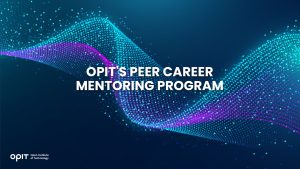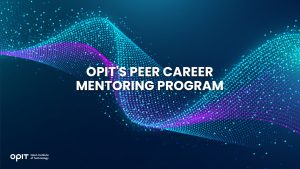

For most people, graduating is one of the happiest times of their lives. It means no more exams, no more deadlines, and no more all-nighters. But this feeling of joy and accomplishment can be quickly overshadowed by a fear of an uncertain future. Throw job market pressure and societal expectations into the mix, and the post-graduation joy quickly turns into post-graduation blues.
But there’s no need for this. Just like your educational institution of choice can get you ready for a career in your desired field, you can prepare yourself for the post-graduation journey. The Open Institute of Technology (OPIT) is here to help in both regards.
This article will guide you through your post-graduation journey, allowing you to relax once your graduation comes and you enter the competitive job market. To give you only the most useful advice, we’ve enlisted the help of one of our alums, Francesca Fancoli. She will chime in with her personal experience pre-, during, and post-OPIT. Let’s begin!
1. Follow Your Heart
It’s perfectly understandable if the words “Follow your heart” sound like nothing more than a cliché to you, especially in the cutthroat business world. But the truth is that genuine passion and intuition can be powerful guides.
Take Francesca as an example. Though she previously focused on climate-related issues and sustainability, she became intrigued by the use of artificial intelligence (AI) in the corporate world. That’s what brought her to OPIT and our Master in Applied Data Science and AI program.
As long as you continuously pursue a career that challenges and motivates you, you’ll likely find both fulfillment and success. This way, you’ll think of studying as not a mundane task but an adventure, just like Francesca does.
2. Network, Network, Network
Don’t let anyone convince you that “networking” is nothing more than a buzzword. Networking is still very much a valuable and effective way to build meaningful connections, gain insights, and open doors to new opportunities in your professional journey. The only thing that has changed is where networking takes place.
Sure, you can still attend formal networking events and career fairs in person, as this will allow you to build confidence and sharpen your interpersonal skills. But nowadays, you can also leverage the power of virtual networking, connecting with professionals globally through online platforms like LinkedIn.
Study online at OPIT, and you also get the chance to interact with classmates and alums from all over the world. For instance, Francesca comes from Italy, but OPIT students and alums can be found in virtually every corner of the world.
Genuinely getting to know your fellow students, professors, and professionals in your desired field can lead to all sorts of unexpected opportunities, as many job openings don’t even get posted online. Instead, they circulate within enclosed professional networks through word of mouth.
3. Don’t Wait for the Right Opportunity – Create It
This tip ties into the importance of networking. Suppose there’s a person you want to meet or a job you really want. If that’s the case, don’t just sit back and hope for an opportunity to achieve these goals comes your way. Instead, make your own opportunity.
Initiating contact and expressing genuine interest paints you as an assertive, proactive, and driven individual. And these qualities are precisely what many employers and influential professionals value. Plus, thanks to LinkedIn, you can demonstrate all these qualities from the comfort of your own home.
4. Create a Standout CV
Once the time comes to send out your CV (curriculum vitae) to your potential employer(s), you’ll want to ensure the CV in question truly stands out. After all, you only get one chance to make a first impression.
Of course, this doesn’t mean you should resort to flashy gimmicks whose only value is their shock factor. It means presenting a visually appealing, well-organized, and impactful document that will instantly set you apart from other candidates.
Though there are many factors in creating a standout CV, one is arguably the most important – customize your CV for the job you want. Nothing screams mediocrity more than submitting a generic CV to every job application.
Let’s say you study computer science and AI like Francesca and want to apply for a job in the field. In this case, your CV should showcase specific hands-on projects you’ve worked on during your studies and the technical skills you’ve mastered. You can even include some industry insight to demonstrate your understanding of the current trends and challenges.
For instance, one of the reasons Francesca chose her field of study at OPIT is that she believes that automation can help with “foreseeing risks” and “applying better compliance.”
5. Don’t Stress About the Interview
Obviously, this is easier said than done. It’s perfectly natural to be nervous before a big interview, especially if it’s your first post-graduation. But as long as you remain confident and express genuine interest in the position (and the company), you’ll likely make an excellent impression.
If you’re like Francesca, use the interview to showcase your passion for AI and computer science in general. Talk about your extracurricular activities in the field and all the fun projects you got to work on during your studies.
Of course, this doesn’t mean you should forget about the “traditional” interview question. Remember that most interviews are a lengthy process, so prepare yourself for the common questions that might come your way during it.
6. Continuously Educate Yourself
Newsflash – learning doesn’t stop once you graduate. Or at least, it shouldn’t. It’s crucial that you continuously strive to learn new skills, adapt to new technologies, and pursue relevant certifications.
That’s precisely what Francesca did when enrolling in OPIT. She sees her time here as “upskilling,” which will help her conquer the corporate job market.
Even if you land your dream job, keep learning and educating yourself. This will allow you to advance quickly and achieve long-term success in your desired field. And remember not to be too hard on yourself if there’s something you don’t know in your new job, as no one expects you to know everything from the get-go.
7. Don’t Fear a Career Break
A career break is nothing to fear and stress about. In fact, it can be a valuable opportunity for personal and professional growth. Take Francesca as an example, as she used her career breaks wisely – one to start a family and the other to study at OPIT.
8. Embrace Volunteering
Let’s say you can’t find a job for a while. Or, you want to use your career break wisely, like Francesca. Whatever the case, consider volunteering.
Volunteering can help you add relevant job experience to your CV and set you up for a successful career. Best of all? If you attend an online institution like OPIT, you might even have time to volunteer during your studies, making the transition from education to employment substantially smoother.
9. Step Out of Your Comfort Zone
It doesn’t matter if you’re currently studying, just graduated, or already in the job market. One thing remains the same – growth happens when you step beyond the familiar.
During studying, challenge yourself to explore different subjects, engage in extracurricular activities, and seek to understand the study materials beyond surface-level comprehension. For instance, during Francesca’s studies, her goal was to “understand the uses of AI in a corporate job and specifically what AI can do for compliance and risk management.”
After graduating and joining the job market, continue seeking opportunities to apply your knowledge in real-world scenarios. Don’t just stick to what you’ve learned or experienced in school. Even if these new experiences inspire you to change your career path, do it! This turned out great for Francesca, and it will surely be the same for you as long as you remain adaptable and embrace challenges with open arms.
Thanks to the digital age, even moving to another country mid-study is feasible, as you can “take” your studies with you. Just ask the lovely Francesca who moved from Italy to France.
10. Be Patient
Once you graduate, not everything will go your way. You might take a while to land your dream job or advance in your career. You might even start a job only to realize it’s not for you after all. And that’s more than OK. Remember that the best things are worth waiting for, and be easy on yourself while waiting for them.
Of course, if you’ve read all the tips outlined in this article, you won’t be waiting idly. You’ll use this time to better yourself, improve your skills, meet new people, and explore alternative paths. Combine these actions with your formal knowledge, and it’s only a matter of time before you reach the top. But more importantly – you’ll also enjoy your journey up there.
Put Your Trust in OPIT
At OPIT, we have one goal – to help you achieve your dream career. This involves empowering you to excel in your chosen field during and after graduation. If you have any questions about our study programs, contact us directly. We’ll be happy to share more tips from our alumni who have successfully navigated their career paths, just like Francesca.
Related posts

Source:
- Raconteur, published on November 06th, 2025
Many firms have conducted successful Artificial Intelligence (AI) pilot projects, but scaling them across departments and workflows remains a challenge. Inference costs, data silos, talent gaps and poor alignment with business strategy are just some of the issues that leave organisations trapped in pilot purgatory. This inability to scale successful experiments means AI’s potential for improving enterprise efficiency, decision-making and innovation isn’t fully realised. So what’s the solution?
Although it’s not a magic bullet, an AI operating model is really the foundation for scaling pilot projects up to enterprise-wide deployments. Essentially it’s a structured framework that defines how the organisation develops, deploys and governs AI. By bringing together infrastructure, data, people, and governance in a flexible and secure way, it ensures that AI delivers value at scale while remaining ethical and compliant.
“A successful AI proof-of-concept is like building a single race car that can go fast,” says Professor Yu Xiong, chair of business analytics at the UK-based Surrey Business School. “An efficient AI technology operations model, however, is the entire system – the processes, tools, and team structures – for continuously manufacturing, maintaining, and safely operating an entire fleet of cars.”
But while the importance of this framework is clear, how should enterprises establish and embed it?
“It begins with a clear strategy that defines objectives, desired outcomes, and measurable success criteria, such as model performance, bias detection, and regulatory compliance metrics,” says Professor Azadeh Haratiannezhadi, co-founder of generative AI company Taktify and professor of generative AI in cybersecurity at OPIT – the Open Institute of Technology.
Platforms, tools and MLOps pipelines that enable models to be deployed, monitored and scaled in a safe and efficient way are also essential in practical terms.
“Tools and infrastructure must also be selected with transparency, cost, and governance in mind,” says Efrain Ruh, continental chief technology officer for Europe at Digitate. “Crucially, organisations need to continuously monitor the evolving AI landscape and adapt their models to new capabilities and market offerings.”
An open approach
The most effective AI operating models are also founded on openness, interoperability and modularity. Open source platforms and tools provide greater control over data, deployment environments and costs, for example. These characteristics can help enterprises to avoid vendor lock-in, successfully align AI to business culture and values, and embed it safely into cross-department workflows.
“Modularity and platformisation…avoids building isolated ‘silos’ for each project,” explains professor Xiong. “Instead, it provides a shared, reusable ‘AI platform’ that integrates toolchains for data preparation, model training, deployment, monitoring, and retraining. This drastically improves efficiency and reduces the cost of redundant work.”
A strong data strategy is equally vital for ensuring high-quality performance and reducing bias. Ideally, the AI operating model should be cloud and LLM agnostic too.
“This allows organisations to coordinate and orchestrate AI agents from various sources, whether that’s internal or 3rd party,” says Babak Hodjat, global chief technology officer of AI at Cognizant. “The interoperability also means businesses can adopt an agile iterative process for AI projects that is guided by measuring efficiency, productivity, and quality gains, while guaranteeing trust and safety are built into all elements of design and implementation.”
A robust AI operating model should feature clear objectives for compliance, security and data privacy, as well as accountability structures. Richard Corbridge, chief information officer of Segro, advises organisations to: “Start small with well-scoped pilots that solve real pain points, then bake in repeatable patterns, data contracts, test harnesses, explainability checks and rollback plans, so learning can be scaled without multiplying risk. If you don’t codify how models are approved, deployed, monitored and retired, you won’t get past pilot purgatory.”
Of course, technology alone can’t drive successful AI adoption at scale: the right skills and culture are also essential for embedding AI across the enterprise.
“Multidisciplinary teams that combine technical expertise in AI, security, and governance with deep business knowledge create a foundation for sustainable adoption,” says Professor Haratiannezhadi. “Ongoing training ensures staff acquire advanced AI skills while understanding associated risks and responsibilities.”
Ultimately, an AI operating model is the playbook that enables an enterprise to use AI responsibly and effectively at scale. By drawing together governance, technological infrastructure, cultural change and open collaboration, it supports the shift from isolated experiments to the kind of sustainable AI capability that can drive competitive advantage.
In other words, it’s the foundation for turning ambition into reality, and finally escaping pilot purgatory for good.

The Open Institute of Technology (OPIT) is the perfect place for those looking to master the core skills and gain the fundamental knowledge they need to enter the exciting and dynamic environment of the tech industry. While OPIT’s various degrees and courses unlock the doors to numerous careers, students may not know exactly which line of work they wish to enter, or how, exactly, to take the next steps.
That’s why, as well as providing exceptional online education in fields like Responsible AI, Computer Science, and Digital Business, OPIT also offers an array of career-related services, like the Peer Career Mentoring Program. Designed to provide the expert advice and support students need, this program helps students and alumni gain inspiration and insight to map out their future careers.
Introducing the OPIT Peer Career Mentoring Program
As the name implies, OPIT’s Peer Career Mentoring Program is about connecting students and alumni with experienced peers to provide insights, guidance, and mentorship and support their next steps on both a personal and professional level.
It provides a highly supportive and empowering space in which current and former learners can receive career-related advice and guidance, harnessing the rich and varied experiences of the OPIT community to accelerate growth and development.
Meet the Mentors
Plenty of experienced, expert mentors have already signed up to play their part in the Peer Career Mentoring Program at OPIT. They include managers, analysts, researchers, and more, all ready and eager to share the benefits of their experience and their unique perspectives on the tech industry, careers in tech, and the educational experience at OPIT.
Examples include:
- Marco Lorenzi: Having graduated from the MSc in Applied Data Science and AI program at OPIT, Marco has since progressed to a role as a Prompt Engineer at RWS Group and is passionate about supporting younger learners as they take their first steps into the workforce or seek career evolution.
- Antonio Amendolagine: Antonio graduated from the OPIT MSc in Applied Data Science and AI and currently works as a Product Marketing and CRM Manager with MER MEC SpA, focusing on international B2B businesses. Like other mentors in the program, he enjoys helping students feel more confident about achieving their future aims.
- Asya Mantovani: Asya took the MSc in Responsible AI program at OPIT before taking the next steps in her career as a Software Engineer with Accenture, one of the largest IT companies in the world, and a trusted partner of the institute. With a firm belief in knowledge-sharing and mutual support, she’s eager to help students progress and succeed.
The Value of the Peer Mentoring Program
The OPIT Peer Career Mentoring Program is an invaluable source of support, inspiration, motivation, and guidance for the many students and graduates of OPIT who feel the need for a helping hand or guiding light to help them find the way or make the right decisions moving forward. It’s a program built around the sharing of wisdom, skills, and insights, designed to empower all who take part.
Every student is different. Some have very clear, fixed, and firm objectives in mind for their futures. Others may have a slightly more vague outline of where they want to go and what they want to do. Others live more in the moment, focusing purely on the here and now, but not thinking too far ahead. All of these different types of people may need guidance and support from time to time, and peer mentoring provides that.
This program is also just one of many ways in which OPIT bridges the gaps between learners around the world, creating a whole community of students and educators, linked together by their shared passions for technology and development. So, even though you may study remotely at OPIT, you never need to feel alone or isolated from your peers.
Additional Career Services Offered by OPIT
The Peer Career Mentoring Program is just one part of the larger array of career services that students enjoy at the Open Institute of Technology.
- Career Coaching and Support: Students can schedule one-to-one sessions with the institute’s experts to receive insightful feedback, flexibly customized to their exact needs and situation. They can request resume audits, hone their interview skills, and develop action plans for the future, all with the help of experienced, expert coaches.
- Resource Hub: Maybe you need help differentiating between various career paths, or seeing where your degree might take you. Or you need a bit of assistance in handling the challenges of the job-hunting process. Either way, the OPIT Resource Hub contains the in-depth guides you need to get ahead and gain practical skills to confidently move forward.
- Career Events: Regularly, OPIT hosts online career event sessions with industry experts and leaders as guest speakers about the topics that most interest today’s tech students and graduates. You can join workshops to sharpen your skills and become a better prospect in the job market, or just listen to the lessons and insights of the pros.
- Internship Opportunities: There are few better ways to begin your professional journey than an internship at a top-tier company. OPIT unlocks the doors to numerous internship roles with trusted institute partners, as well as additional professional and project opportunities where you can get hands-on work experience at a high level.
In addition to the above, OPIT also teams up with an array of leading organizations around the world, including some of the biggest names, including AWS, Accenture, and Hype. Through this network of trust, OPIT facilitates students’ steps into the world of work.
Start Your Study Journey Today
As well as the Peer Career Mentoring Program, OPIT provides numerous other exciting advantages for those who enroll, including progressive assessments, round-the-clock support, affordable rates, and a team of international professors from top universities with real-world experience in technology. In short, it’s the perfect place to push forward and get the knowledge you need to succeed.
So, if you’re eager to become a tech leader of tomorrow, learn more about OPIT today.
Have questions?
Visit our FAQ page or get in touch with us!
Write us at +39 335 576 0263
Get in touch at hello@opit.com
Talk to one of our Study Advisors
We are international
We can speak in:


